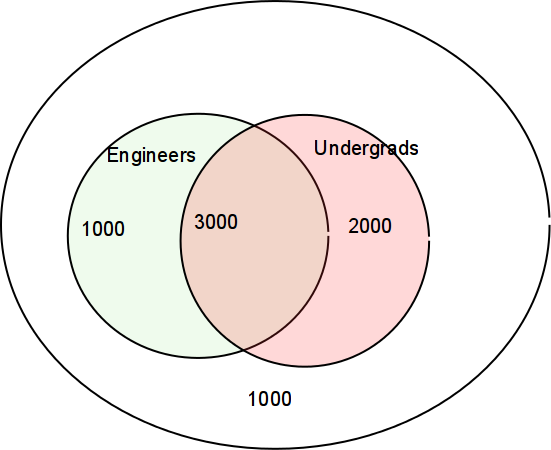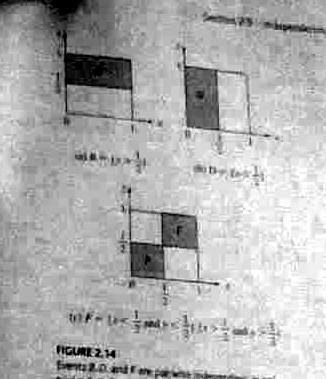Engineering Probability Class 7 Thurs 2021-02-18
Table of contents::
1 Link to lecture videos
is now in the top menu bar.
2 Midterm exam 1
Will be on Mon March 1. To accommodate students in China, the exam will be administered twice.
3 Fictional university, try 2
-
Consider a fictional university that has both undergrads and grads. It also has both Engineers and others:

Compute P[E|U], P[E|U'], P[U|E], etc.
4 Bayes theorem ctd
-
We'll do the defective item example, using both numbers and Bayes rule.
We'll do these examples from Leon-Garcia in class.
Example 2.28, page 51. Assume P[A0]=1/3. P[e]=.1 What is P[A0|B0]?
Example 2.30, page 53, chip quality control: For example 2.28, how long do we have to burn in chips so that the survivors have a 99% probability of being good? p=0.1, a=1/20000.
5 Chapter 2 ctd: Independent events
-
2.5 Independent events
\(P[A\cap B] = P[A] P[B]\)
P[A|B] = P[A], P[B|A] = P[B]
A,B independent means that knowing A doesn't help you with B.
Mutually exclusive events w.p.>0 must be dependent.
Example 2.32, page 55.
-
Example 2.33, page 56.

-
More that 2 events:
N events are independent iff the occurrence of no combo of the events affects another event.
Each pair is independent.
Also need \(P[A\cap B\cap C] = P[A] P[B] P[C]\)
This is not intuitive A, B, and C might be pairwise independent, but, as a group of 3, are dependent.
See example 2.32, page 55. A: x>1/2. B: y>1/2. C: x>y
Common application: independence of experiments in a sequence.
-
Example 2.34: coin tosses are assumed to be independent of each other.
P[HHT] = P[1st coin is H] P[2nd is H] P[3rd is T].
-
Example 2.35, page 58. System reliability
Controller and 3 peripherals.
System is up iff controller and at least 2 peripherals are up.
Add a 2nd controller.
2.6 p59 Sequential experiments: maybe independent
-
2.6.1 Sequences of independent experiments
Example 2.36
-
2.6.2 Binomial probability
Bernoulli trial flip a possibly unfair coin once. p is probability of head.
(Bernoulli did stats, econ, physics, ... in 18th century.)
-
Example 2.37
P[TTH] = \((1-p)^2 p\)
P[1 head] = \(3 (1-p)^2 p\)
Probability of exactly k successes = \(p_n(k) = {n \choose k} p^k (1-p)^{n-k}\)
\(\sum_{k=0}^n p_n(k) = 1\)
Example 2.38
Can avoid computing n! by computing \(p_n(k)\) recursively, or by using approximation. Also, in C++, using double instead of float helps. (Almost always you should use double instead of float. It's the same speed on normal CPUs.)
Example 2.39
Example 2.40 Error correction coding